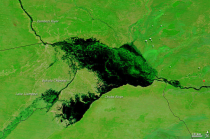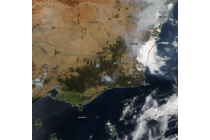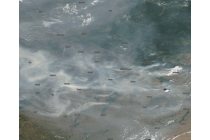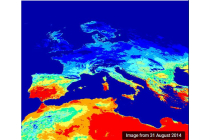Land
Roberto Nicoletta talks about the H SAF P-IN-FCI (H40) instantaneous precipitation and P-AC-FCI (H42) accumulated precipitation products while Semih Kuter discusses the H SAF H43 Snow Cover Product.
This talk introduces the new H SAF P-IN-FCI (H40) instantaneous precipitation and P-AC-FCI (H42) accumulated precipitation products. They are an evolution of the H60 and H61 MSG products, having a significant increment in resolution and time frequency. They are put into evidence via some examples in the European region. Some details are shown to put show the 3-times enhancements in computing performances. How to download the new products through the new website interface is also introduced. EUMETSAT H SAF H43 daily snow cover product provides 2 km resolution binary snow maps derived from MTG-FCI observations. We outline key technical features of H43, demonstrate how to access and download the product via the EUMETSAT Data Services, and present initial validation results from the 2024–2025 winter season using MODIS reference data. Case studies from the European Alps and the Russia/Kazakhstan region illustrate performance across diverse landscapes.
Isabel Trigo gives an overview on LSA SAF products and discusses future development.
Andrea Meraner talks about the new channels on FCI instrument that bring new possibilities within the fire detection area.
The Flexible Combined Imager (FCI) instrument on-board the Meteosat Third Generation (MTG) satellite introduces unprecedented detection capabilities for wildfires from geostationary orbit. This presentation offers an overview of the instrument, focusing on characteristics relevant for identifying hotspots. We will then present case study analyses collected over the commissioning phase of the instrument, focusing on the Portugal September 2024 fires. We will explore visualisations utilising RGBs such as Fire Temperature and True Colour, leveraging the new FCI channels.
Celia Gouveia shows the importance of monitoring the fire risk for preventive measures, as well as impact assessment.
LSA-SAF generates a large set of products for land surface characterization derived from SEVIRI on board Meteosat Second Generation (MSG). The availability of such datasets in Near Real Time (NRT) allows a continuous monitoring of the situation before, during and after wildfire. The monitoring of the situation during the fire season relies on the fire risk mask (FRM) disseminated daily and with 5 days in advance. The severity of the occurred events is assessed by means of Fire Radiative Power. Post fire conditions over burned areas and the assessment of the impact of fire events on vegetation regeneration is assessed by means vegetation products.
Lecture slides
Martin Wooster talks about fire detection and FRP (Fire Radiative Power) product.
Martin Wooster talks about fire detection and FRP (Fire Radiative Power) product.
Lecture slides
Andrea Meraner talks about wildfire detection and vizualisation by using FCI data.
The Flexible Combined Imager (FCI) instrument on-board the Meteosat Third Generation (MTG) satellite introduces unprecedented detection capabilities for wildfires from geostationary orbit. This presentation offers an overview of the instrument, focusing on characteristics relevant for identifying hotspots. We will then present the first case studies of wildfire and smoke observations across Europe and Africa. These examples are based on preliminary commissioning data collected during the extreme events of Summer 2023. We will explore visualisations utilising RGBs such as Fire Temperature and True Colour, leveraging the new FCI channels.
Lecture slides
Johan Strandgren talks about the FCI True Colour Imagery.
The Flexible Combined Imager (FCI) on-board MTG-i1 introduces a unique capability: generating geostationary true colour imagery over Europe and Africa. This is typically achieved by combining data from three channels centred at red, green and blue wavelengths. However, FCI's green channel (0.51 microns) partially misses the spectral reflectance peak of chlorophyll around 0.55 microns, leading to inaccurate depiction of vegetation and barren surfaces. To address this limitation, a novel green band correction technique using the normalized difference vegetation index has been developed and utilized for the first release of true colour images from FCI. The new FCI true colour composite is also the corner stone for the ongoing development of the FCI GeoColor RGB composite. This composite incorporates the elements from the ABI GeoColor composite, by blending true colour imagery with night-time infrared imagery and city lights, as well as other relevant features such as wildfires and LI lightning events.
Lecture slides
Learn how to detect areas covered with snow, ice or cloudy areas.
In this module you will be able to identify geographical features and surface characteristics and conditions through images and satellite products. Although surface features are not the main purpose of meteorological forecasting, being able to identify and distinguish them from atmospheric features can be useful.
To access the resource click here.
Learn how to recognize areas of flooding.
In this module you will be able to identify geographical features and surface characteristics and conditions through images and satellite products. Although surface features are not the main purpose of meteorological forecasting, being able to identify and distinguish them from atmospheric features can be useful.
To access the resource click here.
Learn how to recognize burnt areas.
In this module you will be able to identify geographical features and surface characteristics and conditions through images and satellite products. Although surface features are not the main purpose of meteorological forecasting, being able to identify and distinguish them from atmospheric features can be useful.
To access the resource click here.
Learn how to identify hotspots.
In this module you will be able to identify geographical features and surface characteristics and conditions through images and satellite products. Although surface features are not the main purpose of meteorological forecasting, being able to identify and distinguish them from atmospheric features can be useful.
To access the resource click here.
Learn how to identify areas of drought and heatwaves.
In this module you will be able to identify geographical features and surface characteristics and conditions through images and satellite products. Although surface features are not the main purpose of meteorological forecasting, being able to identify and distinguish them from atmospheric features can be useful.
To access the resource click here.





